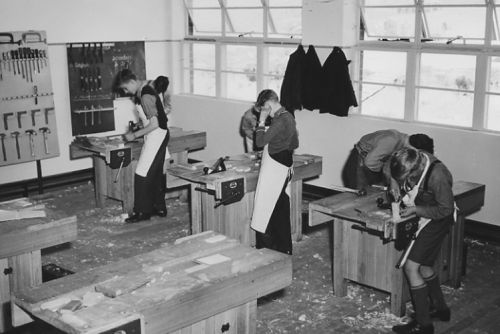 |
 |
|
Technical Education
Technical Education in Tasmania was the product of a fusion of class interests in the late nineteenth century. Government and business wanted a skilled labour force to further the colony's economic development. Artisans, craftsmen and followers of the English South Kensington movement recognised that education in the principles of technical arts, crafts and sciences added value to the workers' product and in turn improved their quality of life. The press followed both arguments and parliament made provision for 'the teaching of the principles of technical education' in twhe Education Act (1885). Regulations specifying courses of instruction and establishing a committee of Technical Education followed in 1887. The first government Technical School opened in Hobart in 1888, offering evening classes in technical art and applied mechanics. Two months later a school was established in Launceston. Small classes were also held in regional centres and Schools of Mines were established in Zeehan, Queenstown and Beaconsfield. Curricula quickly expanded to include subjects ranging from mineralogy and metallurgy to commercial economy, beginning the long tradition of directly linking the schools with the interests of business and industry. The Technical Schools largely worked independently, with varying degrees of success, until 1916 when a Commission of Inquiry recommended the integration of technical education into the state education system. The outcome was a new Technical Education Branch, formed to administer Technical Schools and Schools of Mines and to provide a structured technical education system, comprising distinct trade certificates and applied sciences, engineering and arts diploma courses. Advisory committees were established to ensure course content was relevant to industry requirements. A key recommendation was the creation of Junior Technical Schools, to operate in parallel to the state high schools, for boys who were deemed vocationally oriented or 'destined' for a trade. Two Junior Technical Schools opened in 1919, one in Hobart and the other in Launceston. A recommended school of domestic economy was never established. The structure remained static over the next forty years. The experience of the Depression heightened demands for technical skills, and the technical colleges, with commonwealth assistance, took on responsibilities in the areas of defence training and in post-war rehabilitation schemes. This greatly expanded the courses on offer and firmly established daytime and full-time technical education. Courses in commerce and management grew rapidly while traditional trade and engineering areas became more specialised. The sector was, however, still starved of funds. In the late 1960s, as part of general educational change, technical education began to undergo its most radical change for decades. This began with the departure of all diploma courses to the new Tasmanian College of Advanced Education, which left the Technical Colleges to specialise in trade and technician training. In the 1970s, a plethora of federal and state government reports on post-secondary education reflected a shift in the national economic and social structure and transformed technical education. Its expansion and change in philosophy was signified by the new acronym TAFE – Technical and Further Education. Today vocational education and training continues to cater for a diverse society in an ever-changing world. Further reading: B Proverbs, From the beginning, Launceston, 1988; J Waters, 'The cultured mind, the skilful hand', Hobart, 1988. Jill Waters |
Copyright 2006, Centre for Tasmanian Historical Studies |
